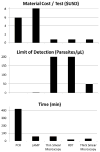Hemozoin detection may provide an inexpensive, sensitive, 1-minute malaria test that could revolutionize malaria screening
- PMID: 27530228
- PMCID: PMC5224914
- DOI: 10.1080/14787210.2016.1222900
Hemozoin detection may provide an inexpensive, sensitive, 1-minute malaria test that could revolutionize malaria screening
Abstract
Malaria remains widespread throughout the tropics and is a burden to the estimated 3.5 billion people who are exposed annually. The lack of a fast and accurate diagnostic method contributes to preventable malaria deaths and its continued transmission. In many areas diagnosis is made solely based on clinical presentation. Current methods for malaria diagnosis take more than 20 minutes from the time blood is drawn and are frequently inaccurate. The introduction of an accurate malaria diagnostic that can provide a result in less than 1 minute would allow for widespread screening and treatment of endemic populations, and enable regions that have gained a foothold against malaria to prevent its return. Using malaria parasites' waste product, hemozoin, as a biomarker for the presence of malaria could be the tool needed to develop this rapid test.
Keywords: Magneto-Optical Detection; Malaria; RDT; elimination; hemozoin; rapid diagnostic.
Conflict of interest statement
Declaration of interest This paper was supported by grants from the Case-Coulter Translational Research Partnership (grant number: SPC507775) and the National Institutes of Health (National Heart, Lung and Blood Institute grant number: HL119810; National Institute of Allergy and Infectious Diseases grant number: AI116709). The authors have no other relevant affiliations or financial involvement with any organization or entity with a financial interest in or financial conflict with the subject matter or materials discussed in the manuscript apart from those disclosed.
Figures

Similar articles
-
Review of Microdevices for Hemozoin-Based Malaria Detection.Biosensors (Basel). 2022 Feb 11;12(2):110. doi: 10.3390/bios12020110. Biosensors (Basel). 2022. PMID: 35200370 Free PMC article. Review.
-
Evaluation of a novel magneto-optical method for the detection of malaria parasites.PLoS One. 2014 May 13;9(5):e96981. doi: 10.1371/journal.pone.0096981. eCollection 2014. PLoS One. 2014. PMID: 24824542 Free PMC article.
-
A magneto-optic route toward the in vivo diagnosis of malaria: preliminary results and preclinical trial data.Biophys J. 2008 Jul;95(2):994-1000. doi: 10.1529/biophysj.107.128140. Epub 2008 Apr 4. Biophys J. 2008. PMID: 18390603 Free PMC article.
-
Nuclear magnetic resonance: a tool for malaria diagnosis?Am J Trop Med Hyg. 2011 Nov;85(5):815-7. doi: 10.4269/ajtmh.2011.11-0299. Am J Trop Med Hyg. 2011. PMID: 22049032 Free PMC article.
-
The Future in Sensing Technologies for Malaria Surveillance: A Review of Hemozoin-Based Diagnosis.ACS Sens. 2021 Nov 26;6(11):3898-3911. doi: 10.1021/acssensors.1c01750. Epub 2021 Nov 4. ACS Sens. 2021. PMID: 34735120 Review.
Cited by
-
An ON-OFF Magneto-Optical Probe of Anisotropic Biofluid Crystals: A β-Hematin Case Study.IEEE Trans Magn. 2021 Sep;57(9):5200211. doi: 10.1109/tmag.2021.3096046. Epub 2021 Jul 9. IEEE Trans Magn. 2021. PMID: 35813117 Free PMC article.
-
Evaluation of Malaria Diagnostic Methods as a Key for Successful Control and Elimination Programs.Trop Med Infect Dis. 2020 Jun 19;5(2):102. doi: 10.3390/tropicalmed5020102. Trop Med Infect Dis. 2020. PMID: 32575405 Free PMC article. Review.
-
Recent Progress in the Development of Diagnostic Tests for Malaria.Diagnostics (Basel). 2017 Sep 19;7(3):54. doi: 10.3390/diagnostics7030054. Diagnostics (Basel). 2017. PMID: 28925968 Free PMC article. Review.
-
Review of Microdevices for Hemozoin-Based Malaria Detection.Biosensors (Basel). 2022 Feb 11;12(2):110. doi: 10.3390/bios12020110. Biosensors (Basel). 2022. PMID: 35200370 Free PMC article. Review.
-
On-chip magnetophoretic capture in a model of malaria-infected red blood cells.Biotechnol Bioeng. 2022 Apr;119(4):1129-1141. doi: 10.1002/bit.28030. Epub 2022 Jan 25. Biotechnol Bioeng. 2022. PMID: 34984673 Free PMC article.
References
-
- World Health Organization. World Malaria Report: 2015. Geneva: World Health Organization; 2015.
-
- Schlitzer M. Antimalarial drugs - what is in use and what is in the pipeline. Arch Pharm (Weinheim) 2008;341:149–63. - PubMed
-
- Medicines For Malaria Venture. [Accessed June 1, 2016];Status: the evolving malaria drug pipeline. http://www.rollbackmalaria.org/files/files/partnership/wg/wg_procurement....
Publication types
MeSH terms
Substances
Grants and funding
LinkOut - more resources
Full Text Sources
Other Literature Sources
Medical
